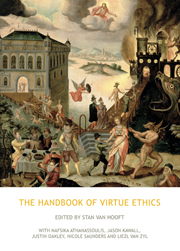Book contents
- Frontmatter
- Contents
- Acknowledgements
- 1 Introduction
- PART I NORMATIVE THEORY
- 2 Eudaimonia in contemporary virtue ethics
- 3 Stoic virtue ethics
- 4 Naturalistic virtue ethics and the new biology
- 5 Virtue ethics and moral sentimentalism
- 6 Virtue ethics and utilitarianism
- 7 Virtues and rules
- 8 Virtue ethics, virtue theory and moral theology
- 9 Nietzsche's virtue ethics
- 10 Right action and the targets of virtue
- 11 Qualified agent and agent-based virtue ethics and the problems of right action
- 12 The virtuous person and normativity
- 13 Virtue and identity
- PART II TYPES OF VIRTUES
- PART III APPLIED ETHICS
- PART IV THE PSYCHOLOGY OF VIRTUE
- Contributors
- References
- Index
13 - Virtue and identity
from PART I - NORMATIVE THEORY
- Frontmatter
- Contents
- Acknowledgements
- 1 Introduction
- PART I NORMATIVE THEORY
- 2 Eudaimonia in contemporary virtue ethics
- 3 Stoic virtue ethics
- 4 Naturalistic virtue ethics and the new biology
- 5 Virtue ethics and moral sentimentalism
- 6 Virtue ethics and utilitarianism
- 7 Virtues and rules
- 8 Virtue ethics, virtue theory and moral theology
- 9 Nietzsche's virtue ethics
- 10 Right action and the targets of virtue
- 11 Qualified agent and agent-based virtue ethics and the problems of right action
- 12 The virtuous person and normativity
- 13 Virtue and identity
- PART II TYPES OF VIRTUES
- PART III APPLIED ETHICS
- PART IV THE PSYCHOLOGY OF VIRTUE
- Contributors
- References
- Index
Summary
According to Thomas Nagel, the requirements of morality “are not imposed from outside, but reflect our own disposition to view ourselves, and our need to accept ourselves, from outside. Without such acceptance we will be in a significant way alienated from our lives” (Nagel 1986: 138).
This quotation hints at a solution to what I will call “Smith's problem” after Michael Smith who has most clearly articulated it (M. Smith 1994). This problem maps onto the debate between the Kantian and the Humean traditions in ethics. Kantians argue that moral norms are grounded in reason. By exploring the very concepts of morality and freedom we discover that we cannot but give ourselves the moral law autonomously and that it would be inconsistent and self-defeating on the norms of rationality to will to perform an immoral action. In this way, reason can establish certain “moral facts” such as that giving a false promise would be wrong. But the problem here is that this discovery does not provide us with a motivation to do right and avoid evil. We may acknowledge the rationality of doing right without being motivated to do so, just as I may acknowledge the rationality of taking an umbrella on a day when rain is expected but decide, in a devil-may-care mood, not to do so. If considerations of rational prudence can be ignored, how much more could the facts of morality be ignored?
- Type
- Chapter
- Information
- The Handbook of Virtue Ethics , pp. 153 - 162Publisher: Acumen PublishingPrint publication year: 2013

